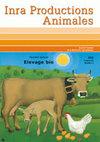控制奶牛群健康的流行病学和杠杆:七种主要疾病的专论方法
IF 0.6
4区 农林科学
Q3 Agricultural and Biological Sciences
引用次数: 2
摘要
动物健康管理的决策取决于各种各样的情况和问题。为了说明这一点,对奶牛群的七种主要疾病进行了分析,以确定当前控制方案有效性的主要限制因素以及在现场进行更好控制的前景。关于乳腺内感染,研究方向集中在多价疫苗的开发、更好地选择奶牛抗生素治疗的工具、农场干预方法以及通过全基因组选择技术的贡献增强动物耐药性。对于胃肠道强虫,也优先考虑合理和选择性的驱虫药治疗,先天抗性的遗传改善似乎不如小型反刍动物优先。Mortellaro病是一种运动障碍,由于预计用于足浴的主要消毒剂将被禁用,因此应注意开发替代方案。Q热控制可以通过延长整个牛群的疫苗接种和适当的分娩卫生管理来达到。约翰氏病可能是基因组选择的一个很好的候选疾病,特别是考虑到缺乏治疗和非常有效的疫苗,以及存在相当有希望的耐药/恢复力背景。BVDV感染似乎只能通过卫生措施来控制,无论是否与疫苗接种计划相关。通过有针对性的监测和快速、大规模的疫苗接种,可以消灭外来血清型BTV。所研究疾病的病原学、流行病学和控制技术的特殊性使我们不能得出一般的结论。本文章由计算机程序翻译,如有差异,请以英文原文为准。
Epidémiologie et leviers pour la maîtrise de la santé des troupeaux bovins laitiers : approche monographique pour sept maladies majeures
Decisions in animal health management depend on a large variety of situations and problems. To illustrate this, seven major diseases of dairy herds were analysed to identify the main limiting factors for the effectiveness of the current control schemes and the perspectives toward better control in the field. Regarding intramammary infections, research directions focus on the development of multivalent vaccines, tools to better select cows to be treated with antibiotics, on-farm intervention methodology and the enhancement of animal resistance via a contribution of genome-wide selection techniques. For gastro-intestinal strongyloses, priority was also given to rational and selective anthelmintic treatments, genetic improvement of innate resistance seeming less a priority than for small ruminants. The control of Mortellaro disease, a locomotor disorder, should receive attention to develop alternatives because of the forecasted ban of the principal disinfectants used for footbaths. Q fever control can be reached by prolonged vaccination of the whole herd and adequate management of parturition hygiene. Johne disease is probably a good candidate disease for genomic selection, especially given the absence of treatment and very effective vaccine and the presence of a quite promising background of resistance/resilience. Infection by BVDV seems to be controllable by only sanitary measures, associated or not with a vaccination scheme. Eradication of exotic serotypes of BTV can be reached by targeted surveillance and quick and massive vaccination. Specificities in etiology, epidemiology and control techniques of the diseases under study do not quite allow drawing generic conclusions.
求助全文
通过发布文献求助,成功后即可免费获取论文全文。
去求助
来源期刊

Inra Productions Animales
Multiple-
CiteScore
1.30
自引率
33.30%
发文量
0
审稿时长
>36 weeks
期刊介绍:
This journal publishes scientific update reports, results of experiments and their possible applications, analyses on topical issues and presentation of research, information on scientific events and new publications.
INRA Productions Animales deals with all species of zootechnical interest (herbivores, monogastrics and fish), covering feed and nutrition, physiology, pathology, genetics, production techniques, product quality and production economics.
 求助内容:
求助内容: 应助结果提醒方式:
应助结果提醒方式:


